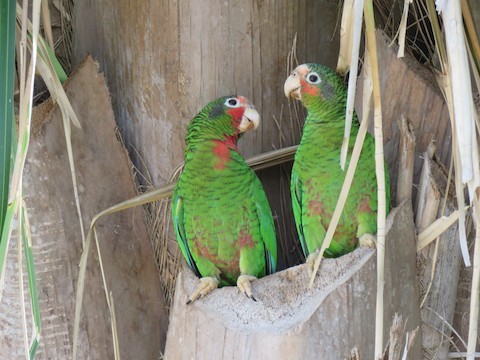Birdfinding.info ⇒ The Cayman Islands endemic form of Rose-throated Parrot is fairly common, having largely recovered from population declines of the late 1900s and early 2000s. On Grand Cayman, it can be found at Botanic Park and along the Mastic Trail. Sporadic in George Town and along the tourist corridor from Seven Mile Beach to West Bay. On Cayman Brac, most reliably found in the Brac Parrot Reserve and adjacent areas.
“Cayman Parrot”
Amazona leucocephala caymanensis
Endemic to Grand Cayman and Cayman Brac, where it is locally common in dry forests.
Populations are closely monitored and have been estimated at approximately 1,900 on Grand Cayman and 450 on Cayman Brac. Extirpated from Little Cayman; occasional reports there may be of wanderers from Cayman Brac.
Identification
The only wild parrot in the Cayman Islands. Its most prominent features include a white forehead, pale bill, pink cheeks, and additional, variable patches of pink that often extend to the lower throat.
Usually shows a dark ear patch and some maroon on the belly and at the base of the tail. The flight feathers are mostly turquoise.
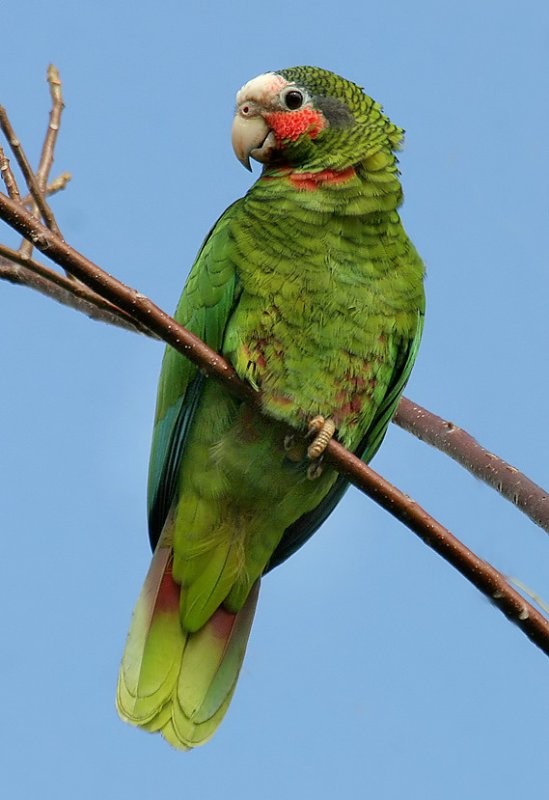
“Cayman Parrot,” A. l. caymanensis. (East End, Grand Cayman; December 14, 2007.) © Steve Metz
The two subspecies, caymanensis of Grand Cayman and hesterna of Cayman Brac, are not readily distinguishable in the field. However, hesterna is somewhat smaller and averages more colorful on the face and belly.

“Cayman Parrot”, A. l. hesterna, showing the extensive blue on its wing. (Christopher Columbus Park, Cayman Brac; March 9, 2021.) © Nicole Martin

“Cayman Parrot,” A. l. caymanensis, pair showing typical infusion of maroon on the belly, with facial colors apparently dulled by dirt. (Queen Elizabeth II Botanic Park, Grand Cayman; July 22, 2013.) © Graham Gerdeman

“Cayman Parrot,” A. l. hesterna. (Brac Parrot Reserve, Cayman Brac; December 26, 2014.) © Christine Kozlosky
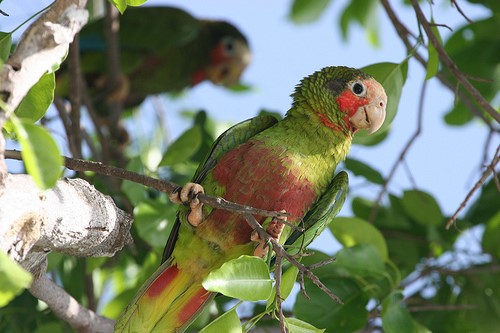
“Cayman Parrot,” A. l. hesterna. (Brac Agriculture Grounds, Cayman Brac; June 3, 2012.) © Simone Scott
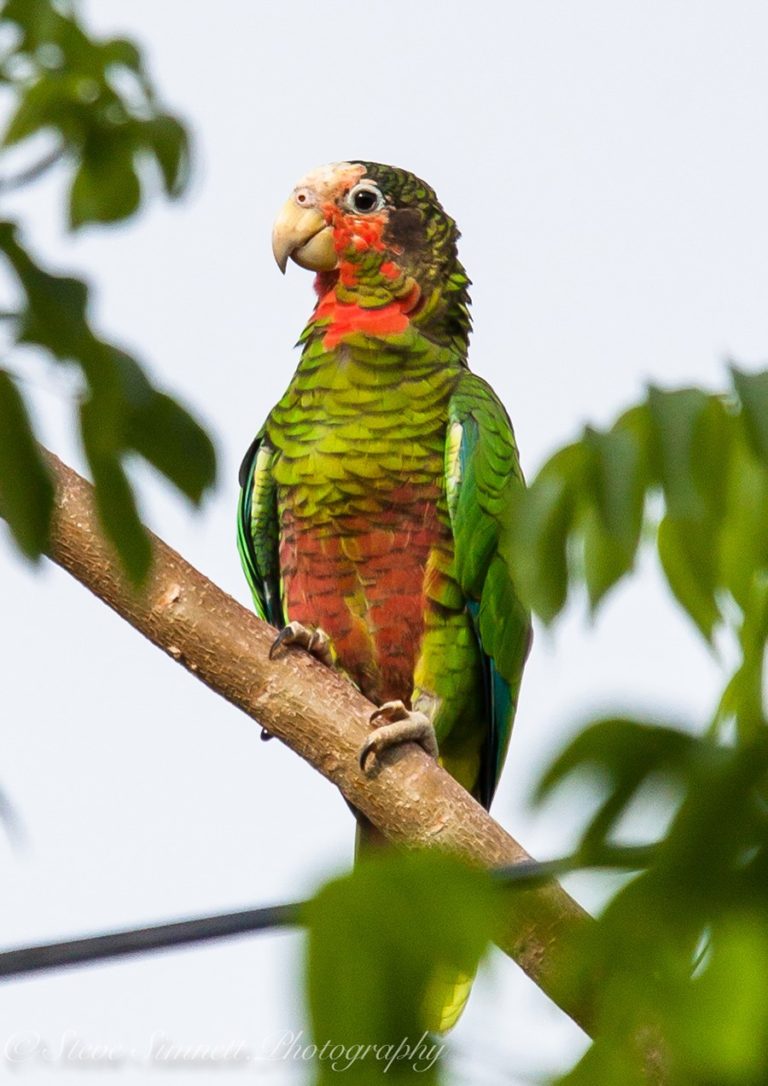
“Cayman Parrot,” A. l. hesterna. (Cayman Brac.) © Steve Simnett

“Cayman Parrot,” A. l. caymanensis, showing minimal pink on the face, mainly on the cheek. (Mastic Trail, Grand Cayman; May 21, 2017.) © Dany Garcia
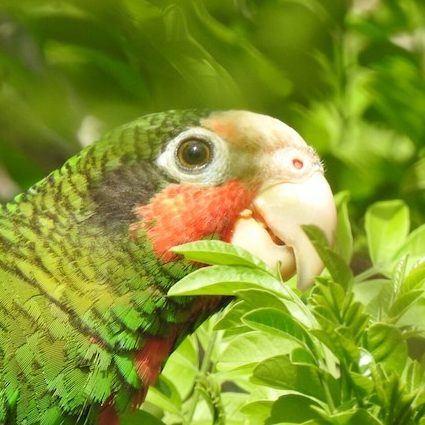
“Cayman Parrot,” A. l. caymanensis, showing moderate pink on the cheek and throat. (Botanic Park, Grand Cayman; April 30, 2017.) Anonymous eBirder

“Cayman Parrot,” A. l. caymanensis, showing extensive pink on the face and throat. (East End, Grand Cayman; December 14, 2007.) © Steve Metz
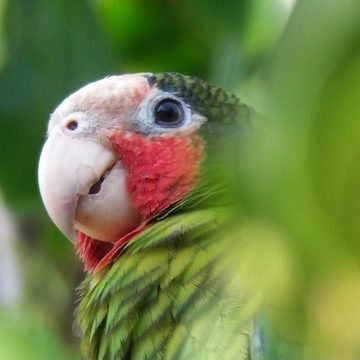
“Cayman Parrot,” A. l. hesterna, showing extensive pink on the face, but little on the throat. (Christopher Columbus Park, Cayman Brac; January 27, 2017.) © Mark Almodovar
Notes
Polytypic form consisting of two recognized subspecies—caymanensis of Grand Cayman and hesterna of Cayman Brac—collectively one of three potentially distinct forms of Rose-throated Parrot (leucocephala).
IUCN Red List Status: Near Threatened.
See below for a comparison of the “Cayman Parrot” with the “Bahama” and “Cuban” Parrots.
Cf. “Bahama” and “Cuban” Parrots. The “Cuban”, “Bahama”, and “Cayman” Parrots are traditionally classified as forms of a single species, which may be appropriate, but their taxonomic status is not definitively settled. Although they do not occur together naturally, vagrancy or transport of captive individuals could take them out of their expected ranges and cause confusion. “Cuban” and “Bahama” both differ from “Cayman” in having far more extensive white on the head and more extensive and contiguous pink on the face, throat, and chest. “Cuban” and “Bahama” differ from one another mainly in the coloration of the belly: green on “Bahama” versus maroon on many “Cubans”. As on “Cuban”, the “Cayman Parrot” often shows extensive maroon on the belly.
More Images of the “Cayman Parrot”
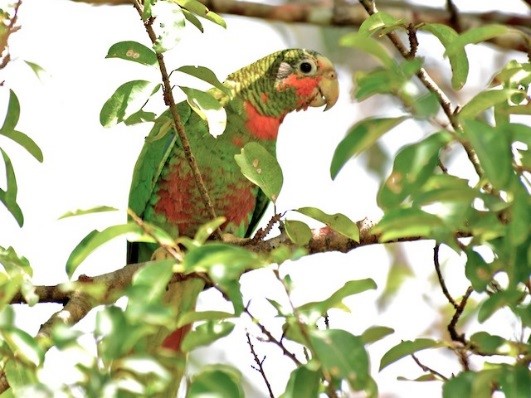
“Cayman Parrot,” A. l. caymanensis. (Grand Cayman; March 19, 2013.) © Alan Van Norman
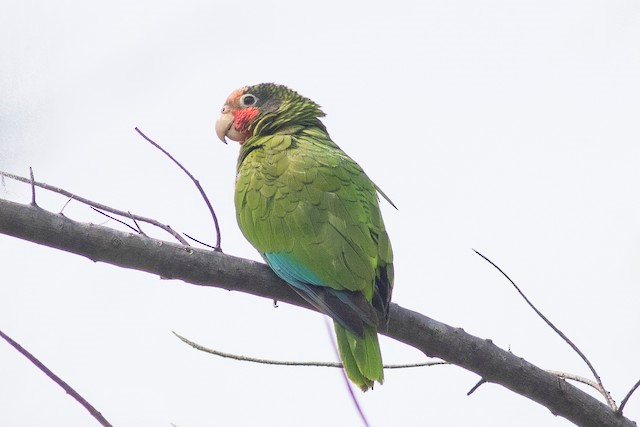
“Cayman Parrot,” A. l. caymanensis, showing turquoise in flight feathers. (West Bay, Grand Cayman; March 19, 2017.) © Charmaine Anderson
References
BirdLife International. 2020. Amazona leucocephala. The IUCN Red List of Threatened Species 2020: e.T22686201A179212864. https://dx.doi.org/10.2305/IUCN.UK.2020-3.RLTS.T22686201A179212864.en. (Accessed January 31, 2022.)
Cayman Compass. 2016. Trust sets sights on Cayman Brac’s parrot habitat, February 2, 2016, https://www.caymancompass.com/2016/02/02/trust-sets-sights-on-cayman-bracs-parrot-habitat/
eBird. 2022. eBird: An online database of bird distribution and abundance. Cornell Lab of Ornithology, Ithaca, N.Y. http://www.ebird.org. (Accessed January 31, 2022.)
Forshaw, J.M. 2010. Parrots of the World. Princeton University Press, Princeton, N.J.
Juniper, T., and M. Parr. 1998. Parrots: A Guide to Parrots of the World. Yale University Press.
Kirwan, G.M., A. Levesque, M. Oberle, and C.J. Sharpe. 2019. Birds of the West Indies. Lynx Edicions, Barcelona.
Raffaele, H., J. Wiley, O. Garrido, A. Keith, and J. Raffaele. 1998. A Guide to the Birds of the West Indies. Princeton University Press.
Xeno-Canto. 2022. Cuban Amazon – Amazona leucocephala. https://xeno-canto.org/species/Amazona-leucocephala. (Accessed January 31, 2022.)
